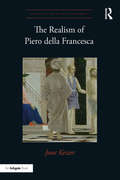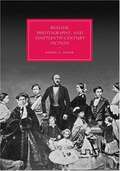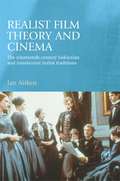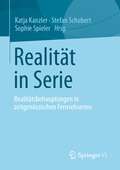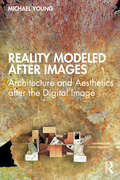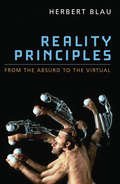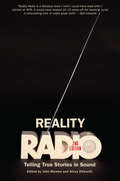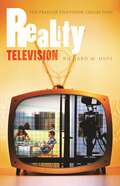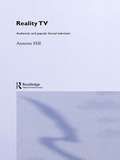- Table View
- List View
Real-World Flash Game Development: How to Follow Best Practices AND Keep Your Sanity
by Christopher GriffithYour deadline just got moved up. Your artist has never worked with Flash before. Your inner programmer is telling you that no OOP is a big Oops! Any Flash developer can share similar tales of woe. This book breaks down the process of Flash game development into simple, approachable steps. Never heard of a game loop before? No idea what a design pattern is? No problem! Chris Griffith gives you real-world expertise, and real-world code that you can use in your own games. Griffith has been building games in Flash long enough to know what works and what doesn't. He shows you what you need to know to get the job done. Griffith covers Flash for the everyday developer. The average Flash developer doesn't have luxurious timelines, employers who understand the value of reusability, or the help of an information architect to design a usable experience. This book helps bridge the gap for these coders who may be used to C++, Java, or C# and want to move over to Flash. Griffith covers real-world scenarios pulled from his own experiences developing games for over 10 years in the industry. The 2nd edition will include: completely new game examples on more advanced topics like 3D; more robust physics and collision detection; and mobile device coverage with Android platform development for us on phones and tablets. Also coverage of the new features available in Flash CS5, Flash Player 10.1, and AIR 2.0 that can be used for game development.The associated web site for the book: www.flashgamebook.com gets close to 1,000 visits a month. On the site, readers can find all the source code for the examples, news on industry happenings, updates and special offers, and a discussion forum to ask questions and share ideas.
Real-World Flash Game Development: How to Follow Best Practices AND Keep Your Sanity
by Christopher GriffithYour deadline just got moved up. Your artist has never worked with Flash before. Your inner programmer is telling you that no OOP is a big Oops! Any Flash developer can share similar tales of woe. This book breaks down the process of Flash game development into simple, approachable steps. Never heard of a game loop before? No idea what a design pattern is? No problem! Chris Griffith gives you real-world expertise, and real-world code that you can use in your own games. Griffith has been building games in Flash long enough to know what works and what doesn't. He shows you what you need to know to get the job done. Griffith covers Flash for the everyday developer. The average Flash developer doesn't have luxurious timelines, employers who understand the value of reusability, or the help of an information architect to design a usable experience. This book helps bridge the gap for these coders who may be used to C++, Java, or C# and want to move over to Flash. Griffith covers real-world scenarios pulled from his own experiences developing games for over 10 years in the industry. The 2nd edition will include: completely new game examples on more advanced topics like 3D; more robust physics and collision detection; and mobile device coverage with Android platform development for us on phones and tablets. Also coverage of the new features available in Flash CS5, Flash Player 10.1, and AIR 2.0 that can be used for game development.The associated web site for the book: www.flashgamebook.com gets close to 1,000 visits a month. On the site, readers can find all the source code for the examples, news on industry happenings, updates and special offers, and a discussion forum to ask questions and share ideas.
Realism and the Audiovisual Media
by L. Nagib C. MelloThis collection examines two recent phenomena: the return of realist tendencies and practices in world cinema and television, and the 'rehabilitation' of realism in film and media theory. The contributors investigate these two phenomena in detail, querying their origins, relations, divergences and intersections from a variety of perspectives.
Realism and Tinsel: Cinema and Society in Britain 1939-48 (Cinema and Society)
by Robert MurphyFirst published in 1992. Routledge is an imprint of Taylor & Francis, an informa company.
Realism and Tinsel: Cinema and Society in Britain 1939-48 (Cinema and Society)
by Robert MurphyFirst published in 1992. Routledge is an imprint of Taylor & Francis, an informa company.
Realism in Greek Cinema: From the Post-War Period to the Present (World Cinema)
by Vrasidas KaralisThe history of Greek cinema post-1945 is best understood through the stories of its most internationally celebrated and influential directors. Focusing on the works of six major filmmakers active from just after WWII to the present day, with added consideration of many others, this book examines the development of cinema as an art form in the social and political contexts of Greece. Insights on gender in film, minority cinemas, stylistic richness and the representation of historical trauma are afforded by close readings of the work and life of such luminaries as Michael Cacoyannis, Nikos Koundouros, Yannis Dalianidis, Theo Angelopoulos, Antouanetta Angelidi, Yorgos Lanthimos, Athena-Rachel Tsangari and Costas Zapas. Throughout, the book examines how directors visually transmute reality to represent unstable societies, disrupted collective memories and national identity.
Realism, Myth, and the Vernacular in Pasolini's Film and Philosophy: Beyond the Middle-Class Matrix
by Max RyynänenPier Paolo Pasolini’s lifework has been studied through the lens of queer studies, film studies, poetry, and many other angles, but there are themes that one could still study. This book aims to bring forth a new understanding of Pasolini as someone who worked in various arts, and through appropriating one art with. Max Ryynänen shows Pasolini’s importance for not just film and film theory, but more broadly visual studies, art research and even cultural philosophy – where Pasolini can be seen to be a real pioneer in discussing unprivileged margins in the society. Ryynänen reads Pasolini not just as a semiotician of film, but also as a cultural philosopher, and argues for that interpretation.
The Realism of Piero della Francesca (Visual Culture in Early Modernity)
by Joost KeizerThe fifteenth-century Italian artist Piero della Francesca painted a familiar world. Roads wind through hilly landscapes, run past farms, sheds, barns, and villages. This is the world in which Piero lived. At the same time, Piero’s paintings depict a world that is distant. The subjects of his pictures are often Christian and that means that their setting is the Holy Land, a place Piero had never visited. The Realism of Piero della Francesca studies this paradoxical aspect of Piero’s art. It tells the story of an artist who could think of the local churches, palaces, and landscapes in and around his hometown of Sansepolcro as miraculously built replicas of the monuments of Jerusalem. Piero’s application of perspective, to which he devoted a long treatise, was meant to convince his contemporaries that his paintings report on things that Piero actually observed. Piero’s methodical way of painting seems to have offered no room for his own fantasy. His art looks deliberately styleless. This book uncovers a world in which painting needed to validate itself by cultivating the illusion that it reported on things observed instead of things imagined by the artist. Piero’s painting claimed truth in a world of increasing uncertainties.
The Realism of Piero della Francesca: Life And Work (Visual Culture in Early Modernity)
by Joost KeizerThe fifteenth-century Italian artist Piero della Francesca painted a familiar world. Roads wind through hilly landscapes, run past farms, sheds, barns, and villages. This is the world in which Piero lived. At the same time, Piero’s paintings depict a world that is distant. The subjects of his pictures are often Christian and that means that their setting is the Holy Land, a place Piero had never visited. The Realism of Piero della Francesca studies this paradoxical aspect of Piero’s art. It tells the story of an artist who could think of the local churches, palaces, and landscapes in and around his hometown of Sansepolcro as miraculously built replicas of the monuments of Jerusalem. Piero’s application of perspective, to which he devoted a long treatise, was meant to convince his contemporaries that his paintings report on things that Piero actually observed. Piero’s methodical way of painting seems to have offered no room for his own fantasy. His art looks deliberately styleless. This book uncovers a world in which painting needed to validate itself by cultivating the illusion that it reported on things observed instead of things imagined by the artist. Piero’s painting claimed truth in a world of increasing uncertainties.
Realism, Photography And Nineteenth-century Fiction (Cambridge Studies In Nineteenth-century Literature And Culture Ser. #60)
by Daniel A. NovakRealist Film Theory and Bicycle Thieves (Film Theory in Practice)
by Hilary NeroniThe Film Theory in Practice series fills a gaping hole in the world of film theory. By marrying the explanation of a film theory with the interpretation of a film, the volumes provide discrete examples of how film theory can serve as the basis for textual analysis. Realist Film Theory and Bicycle Thieves offers a concise introduction to realist film theory in jargon-free language and shows how this theory can be deployed to interpret Vittorio De Sica's 1948 Italian neo realist masterpiece Bicycle Thieves. Hilary Neroni explores the original realist film theorists from the 1940s: André Bazin, Siegfried Kracauer, and Cesare Zavattini, among others. But rather than seeing realist film theory as simply a theory of the past to be moved beyond, the book argues that the prevalence of realism in many different forms within practice and theory suggests the importance of updating this original realist film theory with an understanding of realism that would sustain its viability. Throughout the book, Neroni analyzes neorealist film movements-such as Italian Neorealism, Parallel Cinema of India, and the Iranian New Wave-that challenge mainstream realism with a more radical form that exposes the social order instead of hiding it. Her in-depth investigation of Bicycle Thieves provides a realist methodology that reveals the radicality of its combination of realist techniques, a melodramatic story, and humanist values.
Realist Film Theory and Bicycle Thieves (Film Theory in Practice)
by Hilary NeroniThe Film Theory in Practice series fills a gaping hole in the world of film theory. By marrying the explanation of a film theory with the interpretation of a film, the volumes provide discrete examples of how film theory can serve as the basis for textual analysis. Realist Film Theory and Bicycle Thieves offers a concise introduction to realist film theory in jargon-free language and shows how this theory can be deployed to interpret Vittorio De Sica's 1948 Italian neo realist masterpiece Bicycle Thieves. Hilary Neroni explores the original realist film theorists from the 1940s: André Bazin, Siegfried Kracauer, and Cesare Zavattini, among others. But rather than seeing realist film theory as simply a theory of the past to be moved beyond, the book argues that the prevalence of realism in many different forms within practice and theory suggests the importance of updating this original realist film theory with an understanding of realism that would sustain its viability. Throughout the book, Neroni analyzes neorealist film movements-such as Italian Neorealism, Parallel Cinema of India, and the Iranian New Wave-that challenge mainstream realism with a more radical form that exposes the social order instead of hiding it. Her in-depth investigation of Bicycle Thieves provides a realist methodology that reveals the radicality of its combination of realist techniques, a melodramatic story, and humanist values.
Realist film theory and cinema: The nineteenth-century Lukácsian and intuitionist realist traditions
by Ian Aitken‘Realist film theory and cinema’ embraces studies of cinematic realism and 19th century tradition, the realist film theories of Lukács, Grierson, Bazin and Kracauer, and the relationship of realist film theory to the general field of film theory and philosophy. This is the first book to attempt a rigorous and systematic application of realist film theory to the analysis of particular films. The book suggests new ways forward for a new series of studies in cinematic realism, and for a new form of film theory based on realism. It stresses the importance of the question of realism both in film studies and in contemporary life. Aitken’s work will be of interest to scholars and advanced students of film studies, literary studies, media studies, cultural studies and philosophy.
Realistic Architectural Visualization with 3ds Max and mental ray
by Roger Cusson Jamie CardosoRevitalize your architectural visualizations by bringing new levels of realism to them with an enhanced command of the mental ray toolset in 3ds Max. Full-color step-by-step tutorials give you a firm understanding of the processes and techniques needed to create impressive interior and exterior visualizations. You'll learn how to prepare materials, light a daytime interior scene, use mr Physical Sky, and how to save time during complex renders. The companion website includes all of the tutorial files and sample files from the book.
Realistic Architectural Visualization with 3ds Max and mental ray
by Roger Cusson Jamie CardosoRevitalize your architectural visualizations by bringing new levels of realism to them with an enhanced command of the mental ray toolset in 3ds Max. Full-color step-by-step tutorials give you a firm understanding of the processes and techniques needed to create impressive interior and exterior visualizations. You'll learn how to prepare materials, light a daytime interior scene, use mr Physical Sky, and how to save time during complex renders. The companion website includes all of the tutorial files and sample files from the book.
Realistische Computergraphik: Algorithmen, Datenstrukturen und Maschinen (Informatik-Fachberichte #163)
by Heinrich MüllerRealistische Computergraphik beschäftigt sich mit der Synthese fotoähnlicher, realistischer Bilder aus dreidimensionalen Bildbeschreibungen. In diesem Buch wird zunächst eine kompakte Übersicht über den Stand der Technik dieses aktuellen Teilgebietes der Graphischen Datenverarbeitung gegeben. Der Schwerpunkt liegt auf der Entwicklung effizienter Algorithmen, Datenstrukturen und Maschinen für das aus der Strahlenoptik der Physik abgeleitete Strahlverfolgungsverfahren (Ray Tracing), das die Synthese von Bildern höchster Qualität, einschließlich Schlagschatten, Spiegelung und Brechung, erlaubt, aber einen entsprechend hohen Berechnungsaufwand erfordert. Die neuen, hier vorgestellten Strukturen und ihre Analyse erlauben eine erhebliche Aufwandsverminderung, die das Strahlverfolgungsverfahren in der Praxis einsetzbar machen, wie an Implementierungen demonstriert wurde. Die verwendeten Techniken sind auch von allgemeinem Interesse in der geometrischen Datenverarbeitung.
Realität in Serie: Realitätsbehauptungen in zeitgenössischen Fernsehserien
by Katja Kanzler Stefan Schubert Sophie SpielerRealität(streue) ist ein markantes Thema in der Medienkultur des 21. Jahrhunderts, das sich auf widersprüchliche Weise entfaltet: Realness scheint derzeit sowohl eine Krise als auch eine Konjunktur zu erleben. Der vorliegende Band beleuchtet dieses Thema im medialen Kontext der Fernsehserie mit Hilfe von Fallstudien aus interdisziplinären Perspektiven. Im Mittelpunkt stehen dabei die sozialen, kulturellen, politischen und ästhetischen Potenziale von Realitätsbehauptungen und -effekten in seriellen Fernsehformaten.
Reality Modeled After Images: Architecture and Aesthetics after the Digital Image
by Michael YoungReality Modeled After Images: Architecture and Aesthetics after the Digital Image explores architecture’s entanglement with contemporary image culture. It looks closely at how changes produced through technologies of mediation alter disciplinary concepts and produce political effects. Through both historical and contemporary examples, it focuses on how conventions of representation are established, maintained, challenged, and transformed. Critical investigations are conjoined with inquiries into aesthetics and technology in the hope that the tensions between them can aid an exploration into how architectural images are produced, disseminated, and valued; how images alter assumptions regarding the appearances of architecture and the environment.For students and academics in architecture, design and media studies, architectural and art history, and related fields, this book shows how design is impacted and changed by shifts in image culture, representational conventions and technologies.
Reality Modeled After Images: Architecture and Aesthetics after the Digital Image
by Michael YoungReality Modeled After Images: Architecture and Aesthetics after the Digital Image explores architecture’s entanglement with contemporary image culture. It looks closely at how changes produced through technologies of mediation alter disciplinary concepts and produce political effects. Through both historical and contemporary examples, it focuses on how conventions of representation are established, maintained, challenged, and transformed. Critical investigations are conjoined with inquiries into aesthetics and technology in the hope that the tensions between them can aid an exploration into how architectural images are produced, disseminated, and valued; how images alter assumptions regarding the appearances of architecture and the environment.For students and academics in architecture, design and media studies, architectural and art history, and related fields, this book shows how design is impacted and changed by shifts in image culture, representational conventions and technologies.
Reality Principles: From the Absurd to the Virtual
by Herbert Blau“Herbert Blau’s long sustained inquiry into theater’s most provocative questions—presence, liveness, and finitude—are, at their deepest level, queries into life. Reality Principles returns us to Blau’s inspiring provocations and extends them to new subjects—9/11 and Ground Zero, the nature of charisma, Pirandello and Strindberg.” —Peggy Phelan, Stanford University Reality Principles gathers recent essays by esteemed scholar and theater practitioner Herbert Blau covering a range of topics. The book’s provocative essays—including “The Emotional Memory of Directing,” “The Faith-Based Initiative of the Theater of the Absurd,” “Virtually Yours: Presence, Liveness, Lessness,” “The Human Nature of the Bot”—were given as keynotes and/or memorial lectures and are collected here for the first time. The essays take up a remarkable array of topics—from body art and the self-inflicted punishments of Stelarc, Orlan, and the Viennese Actionists, to Ground Zero and 9/11—and allow Blau to address critical questions of theater and theory, performance and relevance, the absurd and the virtual, history and illusion, community and memory. Reality Principles offers a panoramic view of Herbert Blau’s perspectives on life and the imitation of life on stage.
Reality Radio, Second Edition: Telling True Stories in Sound (Documentary Arts and Culture, Published in association with the Center for Documentary Studies at Duke University)
by Alexa Dilworth John BiewenThis new revised and expanded edition of Reality Radio celebrates today's best audio documentary work by bringing together some of the most influential and innovative practitioners from the United States, Canada, the United Kingdom, and Australia. With a new foreword and five new essays, this book takes stock of the transformations in radio documentary since the publication of the first edition: the ascendance of the podcast; greater cultural, racial, and topical variety; and the changing economics of radio itself. In twenty-four essays total, documentary artists tell--and demonstrate, through stories and transcripts--how they make radio the way they do, and why. Whether the contributors to the volume call themselves journalists, storytellers, or even audio artists--and although their essays are just as diverse in content and approach--all use sound to tell true stories, artfully. Contributors include Jad Abumrad, Daniel Alarcon, Jay Allison, damali ayo, John Biewen, Emily Botein, Chris Brookes, Scott Carrier, Katie Davis, Sherre DeLys, Ira Glass, Alan Hall, Dave Isay, Natalie Kestecher, Starlee Kine, The Kitchen Sisters, Sarah Koenig and Julie Snyder, Maria Martin, Karen Michel, Joe Richman, Dmae Roberts, Stephen Smith, Alix Spiegel, Sandy Tolan, and Glynn Washington.Jad Abumrad, RadiolabDaniel Alarcon, Radio AmbulanteJay Allison, The Moth Radio Hour, Transom.orgdamali ayo, independent audio producerJohn Biewen, audio program director at CDS, Scene on RadioEmily Botein, vice president of On-Demand Content, WNYCChris Brookes, independent audio producer, Battery RadioScott Carrier, This American Life, Home of the BraveKatie Davis, special projects coordinator at WAMU, Neighborhood StoriesSherre DeLys, 360documentaries, ABC Radio National Ira Glass, This American LifeAlan Hall, independent audio producer, Falling Tree ProductionsDave Isay, StoryCorpsNatalie Kestecher, Pocketdocs, ABC Radio NationalStarlee Kine, Mystery ShowThe Kitchen Sisters, The Hidden World of Girls, Hidden Kitchens Sarah Koenig and Julie Snyder, SerialMaria Martin, Latino USA, GraciasVida Center for MediaKaren Michel, independent audio producerJoe Richman, Radio DiariesDmae Roberts, independent audio producerStephen Smith, APM ReportsAlix Spiegel, InvisibiliaSandy Tolan, independent audio producer, Homelands ProductionsGlynn Washington, Snap Judgment
Reality Television (The Praeger Television Collection)
by Richard M. HuffReality programming—a broad title for unscripted shows that involve non-actors—is really an updated version of a classic television genre that had its first successes decades before The Real World or Survivor made their premieres. NBC launched Try and Do It, a show in which audience members attempted to complete tasks such as whistling with a mouthful of crackers, in 1949. In the 1950s Queen for a Day crowned the most down-trodden of its four contestants, draping her in a sable-trimmed robe and granting a previously declared wish. The wild success reality television has achieved of late has pushed the envelope of such programming ever further away from the genre's innocuous beginnings. The time is now ripe for a look back on how this genre has developed, what it reveals about us, and what has transformed it into one of the most powerful forms of entertainment on television today.Reality programming—a broad title for unscripted shows that involve non-actors—is really an updated version of a classic television genre that had its first successes decades before The Real World or Survivor made their premieres. NBC launched Try and Do It, a show in which audience members attempted to complete tasks such as whistling with a mouthful of crackers, in 1949. In the 1950s Queen for a Day crowned the most down-trodden of its four contestants at the end of each show, draping her in a sable-trimmed robe and granting a previously declared wish. The wild success reality television has achieved of late has pushed the envelope of such programming ever further away—from the genre's innocuous beginnings. The time is now ripe for a look back on how this genre has developed, what it reveals about us, and what has transformed it into one of the most powerful forms of entertainment on television today.Using interviews with network insiders, reality producers, and other experts, Richard Huff supplies fascinating insights into the diverse content and often erratic development of reality television programming, augmenting this information with illuminating general connections between the past and present forms these shows assume. From Queen for a Day through Extreme Makeover, from Cops to Fear Factor, the genre is placed before us in this exhaustive and many-sided account, an account that uncovers the foundations and the future potential of the compelling and dominating phenomenon that is reality television.
Reality Television and the Art of Trivialising Work Health, Safety and Wellbeing
by Trajce CvetkovskiThis book aims to assess the extent to which work health, safety and wellbeing (HSW) considerations are trivialised on the popular Australian reality TV programme, The Block. Reality TV as a genre plays a core feature in media and cultural studies, but there has not been any research on the impact of reality TV on safety culture, or how HSW issues are portrayed in popular media. This research remedies this deficiency and demonstrates contestants are workers on The Block who perform workplace activities. The work-related activities are concerned with construction, building and renovation work; and specifically, participants engage in what are seemingly routine or ordinary everyday life activities; namely housing construction and domestic or home dwelling renovations. It supports the argument claim that contestants on reality TV are defined as workers, and this definition of worker can be extended to other genres. The book ultimately demonstrates that reality television is trivialising HSW for the purposes of satisfying audience desire to consume popular culture, and these activities perpetuate a poor image of best safety practice.
Reality TV: Factual Entertainment and Television Audiences
by Annette HillReality TV restores a crucial, and often absent, element to the critical debate about reality television: the voices of people who watch reality programmes. From Animal Hospital to Big Brother, Annette Hill argues that much can be learned from listening to audience discussion about this popular and rapidly changing television genre. Viewers' responses to reality TV can provide invaluable information to enhance our understanding of both the reality genre and contemporary television audiences. Drawing on quantitative and qualitative audience research to understand how viewers categorise the reality genre, and how they judge the performance of ordinary people and the representation of authenticity within different types of reality programmes. * Do audiences think reality TV is real? * Can people learn from watching reality TV? * How critical are viewers of reality TV? Reality TV argues that audiences are engaged in a critical examination of the development of popular factual television. The book examines how audiences can learn from watching reality programmes, and how viewers think and talk about the ethics of reality TV.
Reality TV: Factual Entertainment and Television Audiences (Key Ideas In Media And Cultural Studies)
by Annette HillReality TV restores a crucial, and often absent, element to the critical debate about reality television: the voices of people who watch reality programmes. From Animal Hospital to Big Brother, Annette Hill argues that much can be learned from listening to audience discussion about this popular and rapidly changing television genre. Viewers' responses to reality TV can provide invaluable information to enhance our understanding of both the reality genre and contemporary television audiences. Drawing on quantitative and qualitative audience research to understand how viewers categorise the reality genre, and how they judge the performance of ordinary people and the representation of authenticity within different types of reality programmes. * Do audiences think reality TV is real? * Can people learn from watching reality TV? * How critical are viewers of reality TV? Reality TV argues that audiences are engaged in a critical examination of the development of popular factual television. The book examines how audiences can learn from watching reality programmes, and how viewers think and talk about the ethics of reality TV.





